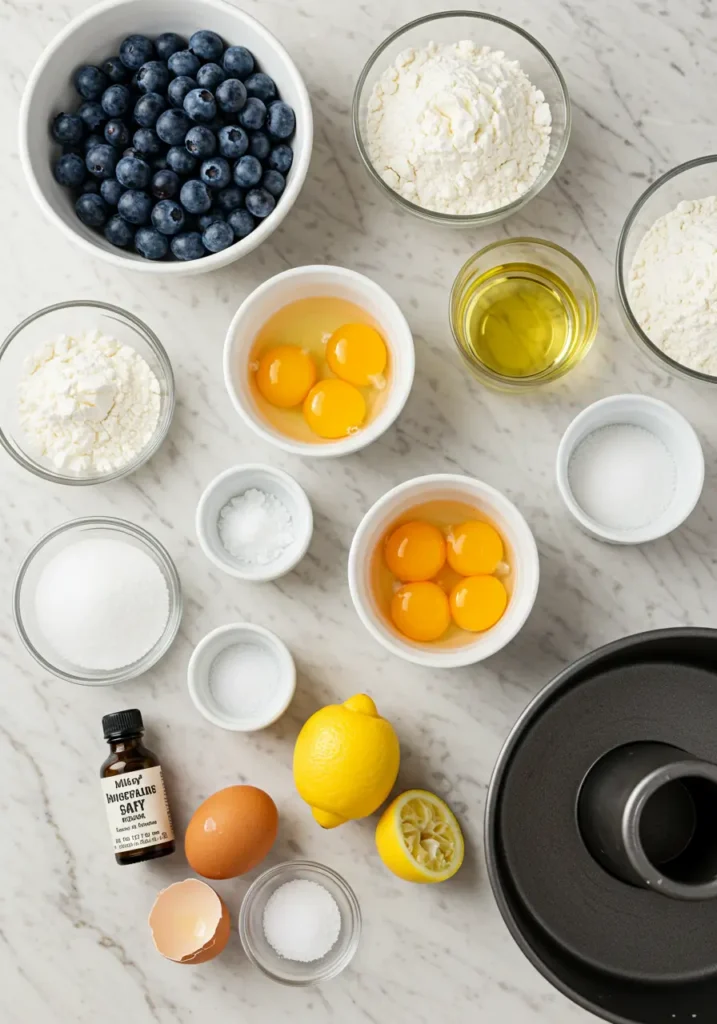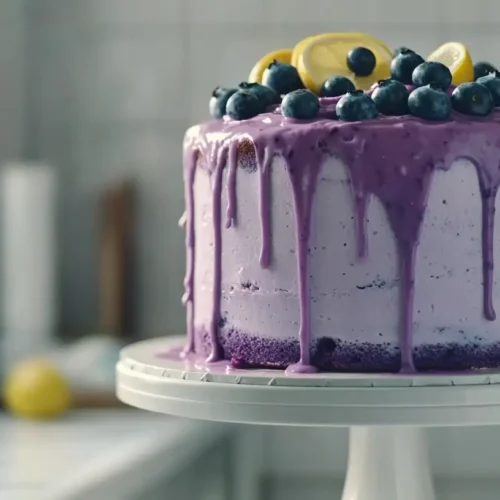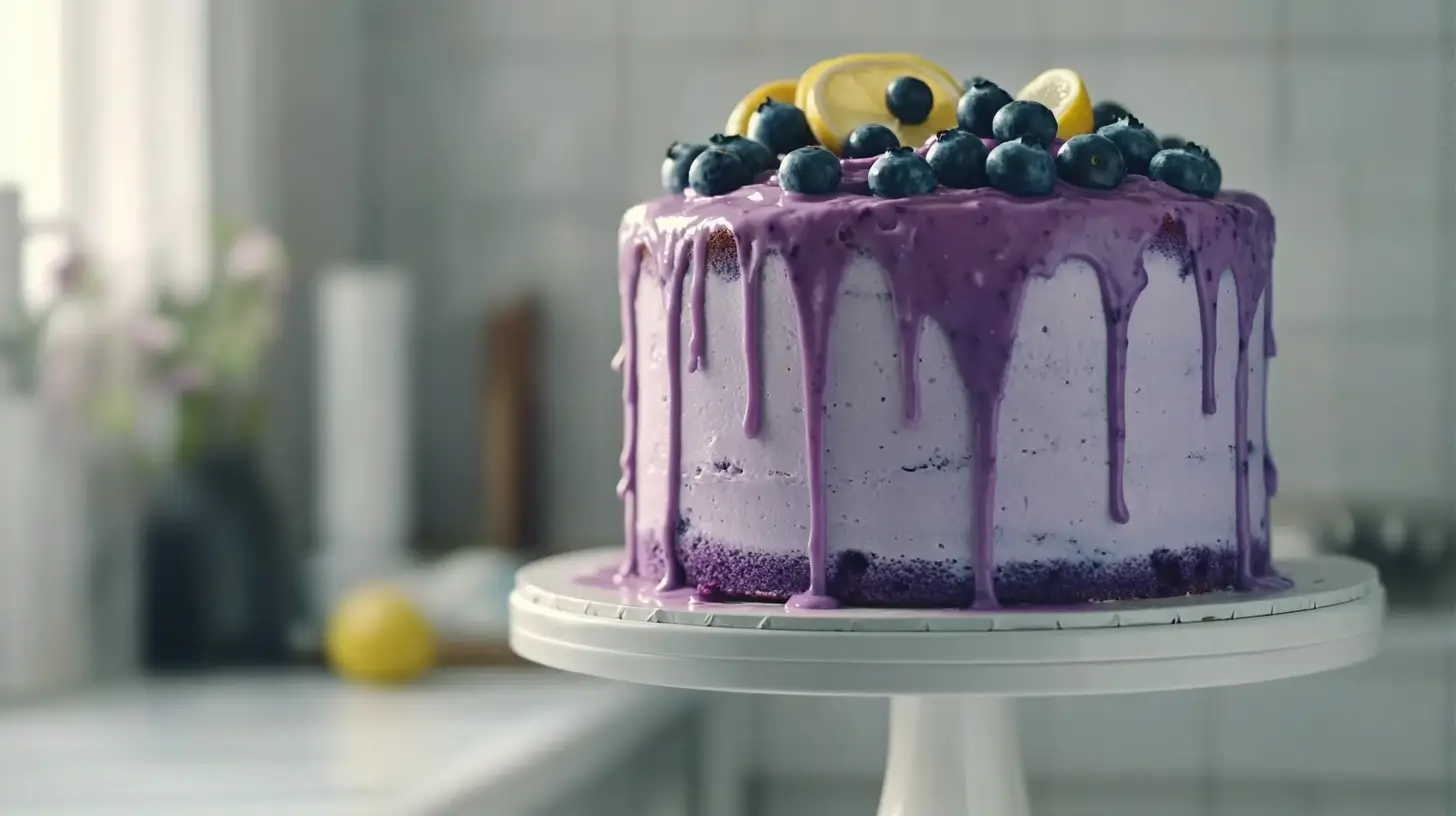Ever had a cake so light it feels like you’re eating a blueberry-flavored cloud? That’s the magic of a blueberry chiffon cake! I’ve been obsessed with this recipe since I first stumbled upon it at my grandmother’s kitchen table years ago, and trust me, once you try it, you’ll understand why.
Unlike dense pound cakes or even traditional sponge cakes, chiffon cakes have this incredible ability to be simultaneously light and moist. Add sweet-tart blueberries to the mix, and you’ve got yourself a game-changer.
Today, I’m sharing my perfected blueberry chiffon cake recipe that’s guaranteed to impress your family, friends, or just your own taste buds on a quiet Sunday afternoon. Ready to create some blueberry magic?
Table of Contents :
What Makes Chiffon Cake Special?
Before we dive into the recipe, let’s talk about what makes chiffon cake different from other cakes you might be familiar with.
Chiffon cake sits in this amazing sweet spot between angel food cake and traditional sponge cake. It’s got the lightness of angel food (thanks to those whipped egg whites!) but the richness and moisture of a sponge cake (hello, egg yolks and oil!).
What sets chiffon cake apart is its use of vegetable oil instead of butter. Oil stays liquid at room temperature, which gives the cake that signature moistness even when it’s cold from the fridge. Butter-based cakes tend to firm up when chilled, but not our beloved chiffon!
Another key characteristic is its distinctive tall, tubular shape with a hole in the middle. This isn’t just for looks—that tube pan helps the delicate batter rise evenly and cool properly.
The Perfect Blueberry Chiffon Cake Recipe
Let me walk you through creating this showstopper of a dessert. Don’t worry if you’re new to chiffon cakes—I’ve included plenty of tips to help you nail it on the first try!
Ingredients : Blueberry Chiffon Cake

For the Cake:
- 2¼ cups cake flour (if you don’t have cake flour, measure out 2¼ cups all-purpose flour, remove 4½ tablespoons, and replace with 4½ tablespoons cornstarch)
- 1½ cups granulated sugar (divided into 1 cup and ½ cup portions)
- 1 tablespoon baking powder
- ½ teaspoon salt
- ½ cup vegetable oil (a neutral oil like canola works best)
- 7 large egg yolks, room temperature
- ¾ cup cold water
- 1 tablespoon vanilla extract
- 1 tablespoon fresh lemon zest
- 7 large egg whites, room temperature
- ½ teaspoon cream of tartar
- 1½ cups fresh blueberries (or frozen, but don’t thaw them)
For the Blueberry Glaze:
- 1 cup powdered sugar
- 2-3 tablespoons blueberry puree (blend about ½ cup fresh blueberries and strain)
- 1 tablespoon lemon juice
- ½ teaspoon vanilla extract
Step-by-Step Instructions : Blueberry Chiffon Cake

Step 1: Prepare Your Equipment and Ingredients
Preheat your oven to 325°F (165°C). This lower temperature ensures the cake bakes slowly and evenly.
Important note: DO NOT grease your tube pan! I know this sounds counterintuitive, but the batter needs to cling to the sides of the pan to rise properly. A greased pan will prevent this and give you a sad, flat cake. 🙁
Separate your eggs while they’re cold (it’s easier), but then let both the whites and yolks come to room temperature for about 30 minutes. Room-temperature egg whites whip up much better than cold ones!
Step 2: Prepare the Blueberries
If using fresh blueberries, rinse them gently and pat them completely dry. Toss them in 1 tablespoon of your measured cake flour. This coating helps prevent them from sinking to the bottom of the cake.
For frozen blueberries, keep them frozen until the last minute, then toss in flour as above. Using them frozen helps them not “bleed” too much into the batter.
Step 3: Mix the Dry Ingredients
In a large bowl, sift together the cake flour, 1 cup of sugar (saving the remaining ½ cup for the egg whites), baking powder, and salt. Sifting is crucial for a light cake, so don’t skip this step!
Step 4: Mix the Wet Ingredients
In a separate bowl, whisk together the vegetable oil, egg yolks, water, vanilla extract, and lemon zest until well combined.
Step 5: Combine Wet and Dry Ingredients
Pour the wet ingredients into the dry ingredients and whisk until you have a smooth batter. Be careful not to overmix—stop as soon as the ingredients are incorporated.
Step 6: Whip the Egg Whites
In a clean, dry mixing bowl (any grease will prevent proper whipping!), beat the egg whites on medium speed until foamy. Add the cream of tartar and continue beating.
Gradually add the remaining ½ cup sugar while beating. Increase the speed to high and beat until stiff peaks form. The egg whites should stand up straight when you lift the beaters.
Pro tip: To check if your egg whites are ready, turn the bowl upside down—if they don’t slide out, they’re perfect!
Step 7: Fold in the Egg Whites
Using a rubber spatula, gently fold about one-third of the egg whites into the batter to lighten it. Then fold in the remaining egg whites in two additions. The goal is to incorporate them without deflating all that air you just whipped in.
Ever seen someone fold egg whites into batter and wondered what the technique actually is? Think of it as a “cut down the middle, scoop from the bottom, and turn over” motion. Don’t stir in circles—that’s a quick way to deflate your batter!
Step 8: Fold in the Blueberries
Gently fold in the flour-coated blueberries until just distributed. Again, be gentle—we want to keep as much air in the batter as possible.
Step 9: Pour and Bake
Pour the batter into your ungreased 10-inch tube pan. Run a knife through the batter to remove any large air pockets.
Bake at 325°F for 55-60 minutes, or until a toothpick inserted comes out clean and the top springs back when lightly touched.
Step 10: Cool Properly (This Is Crucial!)
Immediately after removing from the oven, invert the pan onto a bottle or funnel if your pan doesn’t have “legs” to stand on. The cake must cool completely upside down to prevent it from collapsing.
Let it cool for at least 1½ hours before attempting to remove it from the pan.
Step 11: Remove from Pan
Once completely cool, run a thin knife around the edges of the pan and around the central tube. Gently remove the cake.
Step 12: Prepare the Glaze
In a small bowl, whisk together powdered sugar, blueberry puree, lemon juice, and vanilla extract until smooth. If the glaze is too thick, add a bit more lemon juice. If it’s too thin, add more powdered sugar.
Step 13: Glaze and Serve
Drizzle the glaze over the cooled cake. For a more polished look, you can let the first layer of glaze set before adding another.
Garnish with fresh blueberries and lemon zest if desired.
Video Tutorial : Blueberry Chiffon Cake
Here’s a quick demonstration of the key steps for making the perfect blueberry chiffon cake:
Troubleshooting Your Blueberry Chiffon Cake
Why is my cake sinking?
If your beautiful chiffon cake deflates faster than my mood when I run out of coffee, there could be a few culprits:
- You didn’t cool it upside down: Chiffon cakes MUST cool upside down or gravity will pull your fluffy creation down into a dense pancake.
- Your egg whites weren’t stiff enough: Egg whites provide the structure. If they’re under-whipped, the cake won’t have enough support.
- You overmixed when folding: Too much folding knocks out the air bubbles you worked so hard to create.
- Your oven temperature was off: An oven that’s too hot can cause the cake to rise too quickly and then collapse.
Why is my cake dry?
A dry chiffon cake is a sad affair. Here’s what might have gone wrong:
- Overbaking: Even a few extra minutes can dry out this delicate cake.
- Incorrect measuring: Too much flour can make the cake dry. I recommend using a kitchen scale for precision.
- Egg white issues: Overbeaten egg whites can create a dry texture. Stop at stiff peaks, not beyond!
- Cooling too long: While chiffon cakes need to cool completely, leaving them too long (especially in a dry environment) can dry them out.
What if I don’t have a chiffon cake pan?
The tube pan is pretty essential for proper baking and cooling, but if you’re in a pinch:
- You can use an angel food cake pan (essentially the same thing).
- In desperate times, a bundt pan can work, but the cake may not rise as high and could be trickier to remove.
- NEVER use a regular cake pan—the cake won’t bake properly without the center tube.
- If MacGyvering it, you could create a makeshift tube by placing a clean, oven-safe glass bottle in the center of a springform pan. It’s not ideal, but it’s better than nothing!
How do I prevent the cake from sticking to the pan?
Remember, with chiffon cakes, sticking is actually your friend! You need the batter to cling to the sides to rise properly. That said, removal can be tricky:
- Cool the cake completely before attempting removal.
- Use a thin, flexible knife (like a palette knife) to gently separate the edges.
- Be especially careful around the tube part—that’s where sticking often occurs.
- If the cake is being stubborn, try placing the bottom of the pan over a bowl of hot water for a minute. The heat can help release it.

Blueberry Chiffon Cake
Ingredients
- 2¼ cups cake flour
- 1½ cups granulated sugar divided
- 1 tablespoon baking powder
- ½ teaspoon salt
- ½ cup vegetable oil
- 7 large egg yolks room temperature
- ¾ cup cold water
- 1 tablespoon vanilla extract
- 1 tablespoon fresh lemon zest
- 7 large egg whites room temperature
- ½ teaspoon cream of tartar
- 1½ cups fresh blueberries
- For glaze: 1 cup powdered sugar
- For glaze: 2-3 tablespoons blueberry puree
- For glaze: 1 tablespoon lemon juice
- For glaze: ½ teaspoon vanilla extract
Instructions
- Preheat oven to 325°F (165°C). Do not grease the tube pan.
- Sift together cake flour, 1 cup sugar, baking powder, and salt in a large bowl.
- In a separate bowl, whisk together oil, egg yolks, water, vanilla extract, and lemon zest.
- Pour wet ingredients into dry ingredients and whisk until smooth.
- In a clean, dry bowl, beat egg whites until foamy. Add cream of tartar and continue beating.
- Gradually add the remaining ½ cup sugar while beating egg whites until stiff peaks form.
- Gently fold one-third of the egg whites into the batter to lighten it.
- Fold in remaining egg whites in two additions until just incorporated.
- Toss blueberries with 1 tablespoon of flour and gently fold into the batter.
- Pour batter into ungreased tube pan and run a knife through to remove air pockets.
- Bake for 55-60 minutes until toothpick inserted comes out clean.
- Immediately invert pan and cool completely (about 1½ hours).
- Run a thin knife around edges to release cake from pan.
- Prepare glaze by whisking powdered sugar, blueberry puree, lemon juice, and vanilla.
- Drizzle glaze over cooled cake and garnish with fresh blueberries if desired.
Tips & Tricks for Chiffon Cake Success
After years of making chiffon cakes (and dealing with my fair share of flops!), here are my top insider secrets:
- Temperature matters: Room temperature egg whites whip better, and a properly preheated oven is non-negotiable.
- The egg white bowl must be impeccably clean: Any trace of fat will prevent proper whipping. I even wipe my mixing bowl with lemon juice or vinegar before adding the egg whites to ensure it’s fat-free.
- Don’t rush the cooling process: I know it’s tempting to dig in, but patience pays off. A properly cooled chiffon cake will be loftier and more impressive.
- The folding technique is everything: Practice the proper folding motion—cut down through the center with your spatula, scrape along the bottom of the bowl, and turn the mixture over. Repeat until just combined.
- For extra blueberry flavor: Add 1 teaspoon of blueberry extract to the batter if you can find it. It intensifies that berry goodness!
- The “tap test”: Listen to your cake. When it’s done, a gentle tap on top should sound hollow, and the cake should spring back.
- Slicing secret: Use a serrated knife with a gentle sawing motion to avoid crushing your fluffy creation.
Delicious Variations to Try
Lemon Blueberry Chiffon Cake
Enhance the citrus notes by adding the zest of an entire lemon to the batter and replacing 2 tablespoons of the water with fresh lemon juice. The extra tanginess perfectly complements the sweet blueberries.
Orange Blueberry Chiffon Cake
Substitute orange zest for the lemon zest and use 2 tablespoons of fresh orange juice in place of 2 tablespoons of water. Orange and blueberry is an underrated but fantastic flavor combination!
Different Glaze Options
- Lemon Glaze: Mix 1 cup powdered sugar with 2-3 tablespoons fresh lemon juice and ½ teaspoon lemon zest.
- Vanilla Glaze: Combine 1 cup powdered sugar with 2-3 tablespoons milk and 1 teaspoon vanilla extract.
- Cream Cheese Frosting: Beat 4 oz softened cream cheese with 2 tablespoons butter, 1 cup powdered sugar, and ½ teaspoon vanilla until fluffy.
Vegan Blueberry Chiffon Cake
Yes, it’s possible! Here’s how to adapt:
- Replace eggs with aquafaba: Use ¼ cup aquafaba (the liquid from canned chickpeas) per egg. Whip the aquafaba from 7 cans for the “egg whites” and use a commercial egg replacer for the yolks.
- Use plant-based milk instead of water.
- Add 1 tablespoon apple cider vinegar to help with rise.
- Be aware that vegan versions may not rise quite as high but will still be delicious!
Nutritional Information
(Per serving, assuming 12 slices per cake)
- Calories: 285
- Fat: 9g
- Carbohydrates: 46g
- Protein: 5g
- Sugar: 28g
- Fiber: 1g
- Sodium: 170mg
Note: Nutritional values are approximate and may vary based on specific ingredients used.
Understanding Chiffon Cake: A Baker’s Guide
What is Chiffon Cake?
Chiffon cake was invented in 1927 by a California insurance salesman named Harry Baker (yes, his last name was actually Baker!). He kept the recipe secret for 20 years before selling it to General Mills in 1947.
What makes chiffon cake unique is its combination of baking techniques. It uses:
- Whipped egg whites like angel food cake
- Egg yolks and leavening agents like traditional cakes
- Vegetable oil instead of butter
This combination creates a cake that’s airy yet moist, with a texture that remains soft even when refrigerated.
Chiffon vs. Angel Food vs. Sponge Cake: What’s the Difference?
Confused about these similar-looking cakes? Here’s how they compare:
Angel Food Cake:
- Uses only egg whites (no yolks)
- Contains no fat
- Very light and sweet
- Must be cooled upside down
- Typically made in a tube pan
Sponge Cake:
- Uses whole eggs
- Traditionally contains no added fat (though some recipes include butter)
- Gets its rise primarily from whipped eggs
- Tender but slightly drier than chiffon
- Can be made in various pans
Chiffon Cake:
- Uses separated eggs, with whites whipped separately
- Contains vegetable oil for moisture
- Includes baking powder for extra lift
- Combines the best qualities of both angel food and sponge cake
- Requires cooling upside down
- Always made in a tube pan
The Science of Chiffon Cake
Ever wondered why each ingredient matters? Let’s break it down:
Egg Whites: When whipped, egg whites form a protein network that traps air bubbles. This is what gives chiffon cake its structure and height. The addition of cream of tartar helps stabilize these bubbles by lowering the pH.
Egg Yolks: Add richness, color, and flavor while also providing emulsifying properties that help blend the oil into the batter.
Oil: Unlike butter, which is solid at room temperature, oil remains liquid and gives the cake its characteristic moisture. It also allows for a finer crumb texture.
Flour: Provides structure through its gluten proteins. Cake flour is preferred because its lower protein content results in a more tender cake.
Sugar: Beyond sweetness, sugar helps stabilize the egg white foam and contributes to the cake’s tender texture by interfering with gluten development.
Baking Powder: Provides additional leavening through the release of carbon dioxide when heated and when it comes in contact with liquid.
Why Use a Chiffon Cake Pan?
The tube pan isn’t just for looks—it’s essential for proper baking:
- The center tube conducts heat to the middle of the cake, ensuring even baking.
- The straight sides allow the batter to climb and cling as it rises.
- The ungreased surface gives the batter something to hold onto while rising.
- The removable bottom makes it easier to extract the cake without damaging it.
- The “legs” or “feet” on the pan allow for proper upside-down cooling.
Without this specific pan, your chiffon cake simply won’t achieve its full potential height and texture.
Tips for a Perfect Chiffon Cake
These tips apply to any chiffon cake variety you might want to create:
- Sift dry ingredients: This ensures no lumps and helps create that fine, even texture.
- Beat egg whites properly: Underbeaten whites won’t support the cake; overbeaten whites won’t incorporate well and can make the cake dry.
- Use cake flour: Its lower protein content creates a more delicate texture. If substituting all-purpose flour, replace some with cornstarch to lower the protein content.
- Maintain proper temperatures: Room temperature eggs, properly heated oven—temperature precision matters!
- Fold gently but thoroughly: No stirring! The folding motion preserves air bubbles while ensuring even distribution.
- Don’t grease the pan: The batter needs to “climb” the sides of the pan as it rises.
- Cool completely upside down: This is non-negotiable if you want your cake to maintain its height.
- Store properly: Once cooled and removed from the pan, store under a cake dome or loosely covered with foil to prevent drying out.
Blueberry Buying & Preparation Guide
Choosing the Best Blueberries
Whether you’re at the farmers’ market or grocery store, here’s what to look for:
- Color: The best blueberries have a deep, even blue color with a slight silvery “bloom” (that’s the natural waxy coating that protects the berry).
- Firmness: Gently press a few berries between your fingers—they should be firm but slightly yielding, not hard or mushy.
- Size: For baking, medium-sized berries often have the best flavor balance. Very large berries can sometimes be less flavorful.
- Containers: Check the bottom of the container for stains or moisture, which could indicate crushed berries or mold.
- Seasonality: In North America, peak blueberry season is June through August, though you’ll find imported berries year-round.
Fresh vs. Frozen Blueberries
Can’t decide between fresh and frozen? Here’s the scoop:
Fresh Blueberries:
- Pros: Better texture in the finished cake, prettier appearance, no excess moisture
- Cons: More expensive, seasonal, shorter shelf life
Frozen Blueberries:
- Pros: Available year-round, often cheaper, picked at peak ripeness, longer shelf life
- Cons: Can “bleed” color into the batter, may make batter slightly wetter, need special handling
For this recipe, fresh berries are ideal but frozen work well too. If using frozen, don’t thaw them first—use them straight from the freezer after tossing with a bit of flour.
How to Store Blueberries
To keep your blueberries fresh:
- Don’t wash until ready to use: Moisture accelerates spoilage.
- Refrigerate in their original container: Those little ventilation holes are designed to maintain proper humidity.
- Remove any crushed or moldy berries: One bad berry can quickly spoil the bunch.
- For longer storage: Freeze unwashed berries in a single layer on a baking sheet, then transfer to a freezer bag once solid.
Fresh blueberries typically last 5-7 days in the refrigerator when properly stored.
Preparing Blueberries for Baking
A few extra steps make a big difference:
- To wash or not to wash? Yes, definitely wash fresh berries, but do it right before using them, not in advance. Place them in a colander and rinse gently with cool water.
- Dry thoroughly: Spread washed berries on paper towels and pat gently to remove all moisture. Wet berries can make your batter soggy.
- Toss in flour: Coating berries in a tablespoon of flour from your measured amount helps prevent them from sinking to the bottom of the cake.
- To crush or not? For this recipe, we want whole berries for bursts of flavor. However, you could add 2-3 tablespoons of crushed berries to the batter for more distributed blueberry flavor and color.
- Wild vs. cultivated: Wild blueberries are smaller and often more flavorful, but either type works well in this recipe.
Conclusion : Blueberry Chiffon Cake
There you have it—everything you need to know to create a blueberry chiffon cake that’s guaranteed to impress! The combination of that light, airy texture with bursts of sweet-tart blueberries makes this cake perfect for everything from Sunday brunch to special celebrations.
Remember, the key to chiffon cake success lies in those perfectly whipped egg whites, gentle folding, and proper cooling. Don’t be discouraged if your first attempt isn’t perfect—even experienced bakers sometimes have chiffon challenges!
Have you tried making chiffon cake before? What other flavor combinations would you like to try? Let me know in the comments below, and don’t forget to share your creations on social media with #BlueberryChiffonHeaven!

